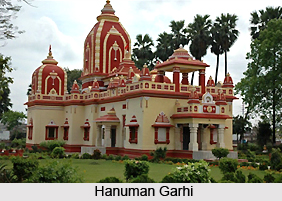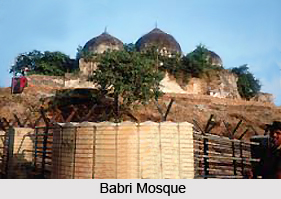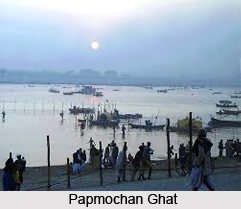 Ayodhya is pre-eminently a city of temples. There are numerous temples, some scattered and some clustered together, besides several Akharas, monasteries, Jain Shrines. Sikh Gurudwaras, mosques and other Muhammadan monuments. The materials employed in the mosques are generally those which were obtained by demolishing Hindu Temples. In 1528 A.D. Babar had come to Ayodhya and halted there for a week. He had destroyed the ancient Janmasthana temple and on its site had built a mosque still known as Babar`s mosque. Ruthless destruction of temples and buildings in the Muhammadan period has deprived the city of many a beautiful specimen of ancient architecture and sculpture.
Ayodhya is pre-eminently a city of temples. There are numerous temples, some scattered and some clustered together, besides several Akharas, monasteries, Jain Shrines. Sikh Gurudwaras, mosques and other Muhammadan monuments. The materials employed in the mosques are generally those which were obtained by demolishing Hindu Temples. In 1528 A.D. Babar had come to Ayodhya and halted there for a week. He had destroyed the ancient Janmasthana temple and on its site had built a mosque still known as Babar`s mosque. Ruthless destruction of temples and buildings in the Muhammadan period has deprived the city of many a beautiful specimen of ancient architecture and sculpture.
Hanuman Garhi in Ayodhya
The chief place of worship in Ayodhya is the ancient citadel of Ramakot reputed to have been built by king Vikramaaditya the foe of Sakas. It stood on elevated ground in the western portion of the city. The old ramaparts have long disappeared, but the mound remains, and on it stands a number of large temples Foremost among these is the Hanuman Garhi, a massive structure in the shape of a four sided fort with circular bastions at each angle. It is said that long ago a great saint known as Abhayaram lived there. His fame had spread far and wide. Nawab Shujauddaula`s son suffered from leprosy, which was pronounced incurable. He was ultimately cured by Abhayaram, the renowned seer. The Nawab, being pleased with the spiritual powers of the saint, got this important temple constructed. The finishing touch was, however, given by Tikitrai, the minister of Assaffuddaula. More than five hundred saints live in this massive temple. The main function of the temple is celebrated on the chaturdash of Krishnapaksh in the month of Kartik.
 The famous temple of Janmabhumi is also situated in Ramkot. The ancient temple reputed to have been built by the king Vikramaaditya was raised to ground by Babar and a mosque was constructed in its place with its materials. The present temple of Janmabhumi is within the boundary of the mosque on a small raised platform. After the construction of the mosque saint Ramadas is said to have chosen a small place north to the old temple for his meditation. This place is known at Janmasthana. According to the Ayodhya Mahatmiya, the fasting on the day of Ramnavami, visiting the place with devotion, giving alms and performing pilgrimages and sacrifices, frees a man from the transmigration of his soul. The Sita-Rasoi or the kitchem of Sitain is nearby. It is situated north-west of the birth place. According to the Ayodhya Mahatmiya Parasuramaa was released from the crime of destroying the Kshatriya when he visited this spot and paid homage to it.
The famous temple of Janmabhumi is also situated in Ramkot. The ancient temple reputed to have been built by the king Vikramaaditya was raised to ground by Babar and a mosque was constructed in its place with its materials. The present temple of Janmabhumi is within the boundary of the mosque on a small raised platform. After the construction of the mosque saint Ramadas is said to have chosen a small place north to the old temple for his meditation. This place is known at Janmasthana. According to the Ayodhya Mahatmiya, the fasting on the day of Ramnavami, visiting the place with devotion, giving alms and performing pilgrimages and sacrifices, frees a man from the transmigration of his soul. The Sita-Rasoi or the kitchem of Sitain is nearby. It is situated north-west of the birth place. According to the Ayodhya Mahatmiya Parasuramaa was released from the crime of destroying the Kshatriya when he visited this spot and paid homage to it.
The ancient building of the famous Kanak-bhawan temple was destroyed by Saiyad Masud Gazi. The Rani of Tikamgarh had erected a new building, which is exquisitely beautiful. To the south of this fine building is Ratnasinghasan marking the place where Rama was installed after his return from exile. The Tulsi Chaura, marking the place where Tulsidas wrote his celebrated Ramayana, is close to the Dantdhavan kund. It is a pity that no befitting memorial has been constructed so far. A small dilapidated building stands to remind the people of the name of the great saint and: poet. The Bara Asthan, the head quarters of a fraternity called the Bara Akhara, the Rang Mahal, Anand Bhawan, the temple of Amar Das, as well as numerous smaller temples and shrines are just close by.
Bathing Tanks and Ghats in Ayodhya
There is a large number of bathing ghats and kundas, which have been elaborately described in the Ayodhya Mahatmiya. Famous among the ghats are the Swargadwar ghat, Papmochan ghat, Lachhman ghat, Raj ghat, Richmochan ghat, Ahalyabai ghat and Jatar ghat. Important among the kundas are the Vidyakund, Sitakund, Agnikund, Hanuman-kund, Vasbisthakund, Bharatkund, Saryakund and Swarn-khanikund.
Akharas in Ayodhya
Besides these temples there are a number of monastic orders affiliated to different religious schools, and sects. Among the numerous sadhus who dwell in these Akharas there are many Bairagis, who are staunch Vaishnavites.
 These Bairagis belong to regularly constituted religious bodies and are divided among seven different akharas or orders. The seven orders have a regular system of precedence which is observed in ceremonial processions and similar occasions. In the front come the Digambaris, followed by the Nirbanis on the right and the Nirmohis on the left. In the third rank behind the Nirbanis march the Khakis on the right and the Niralambhis on the left and after the Nirmohis had come the Santokhis and the Mahanirbanis in the same order. The Digambaris or naked ascetics are said to have been founded by one Bal Rama Das who came to Ayodhya about two hundred and fifty years ago. This order is a small one. The largest community is that of the Nirbanis, who lived in the celebrated Hanuman Garhi temple. They distribute free daily ration to hundreds of sadhus. The Nirmohis claiming spiritual descent from one Govind Das of Jaipur have two branches, one at Ramaghat and the other at Guptarghat. The name signifies, "void of affection." The khaki or ash-besmeared Akhara was established in the days of Shujaud dula by one Daya Rama of Chitrakot. The Niralambis, meaning provisionless, date from the same period. The Santokhis, or contented sadhus, were founded by Rati Rama of Jaipur in the time of Safdar Jang. And lastly the Mahanirbanis or sadhus worshipping without any desire for favours were founded by Purushottam Das in the reign of Shuja-ud-daula.
These Bairagis belong to regularly constituted religious bodies and are divided among seven different akharas or orders. The seven orders have a regular system of precedence which is observed in ceremonial processions and similar occasions. In the front come the Digambaris, followed by the Nirbanis on the right and the Nirmohis on the left. In the third rank behind the Nirbanis march the Khakis on the right and the Niralambhis on the left and after the Nirmohis had come the Santokhis and the Mahanirbanis in the same order. The Digambaris or naked ascetics are said to have been founded by one Bal Rama Das who came to Ayodhya about two hundred and fifty years ago. This order is a small one. The largest community is that of the Nirbanis, who lived in the celebrated Hanuman Garhi temple. They distribute free daily ration to hundreds of sadhus. The Nirmohis claiming spiritual descent from one Govind Das of Jaipur have two branches, one at Ramaghat and the other at Guptarghat. The name signifies, "void of affection." The khaki or ash-besmeared Akhara was established in the days of Shujaud dula by one Daya Rama of Chitrakot. The Niralambis, meaning provisionless, date from the same period. The Santokhis, or contented sadhus, were founded by Rati Rama of Jaipur in the time of Safdar Jang. And lastly the Mahanirbanis or sadhus worshipping without any desire for favours were founded by Purushottam Das in the reign of Shuja-ud-daula.
Thus, it can be concluded saying that Ayodhya is a city of temples spreading the aura of religiosity which is spread throughout the city.



















